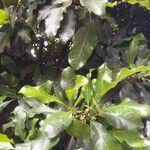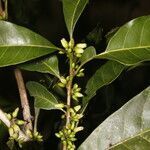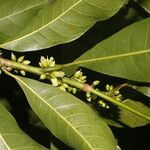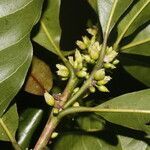Tree to 30 m. Leaves with petioles 5-17 mm long; blades obovate-oblanceolate to elliptic, acute or acuminate, 5-24 cm long, 2-11 cm broad, glabrate, the sec-ondary laterals without particular orientation, the reticulation close. Flowers 1-several per axil, sessile or subsessile (pedicels to 1.5 mm); sepals 4 (2 + 2), 3-4.5 mm long, ovate to oblong-ovate, the inner appressed-sericeous down the middle, otherwise glabrous, the outer soon glabrate; corolla cylindric-urceolate, glabrous, 4.5-8 mm long, the tube 2/3 of the total length, the lobes 4; staminodes linear, flattened, ca 1.5 mm long; staminal filaments ca 2 mm long, attached at the middle of the corolla-tube or slightly below, the anthers ca 1 mm long; ovary 4-locular, densely ascending-sericeous externally (the trichomes 1-2 mm long), the style glabrous, 2-4.5 mm long. Fruit yellow, fleshy, globose to ellipsoid, 5-10 cm long, 4-8 cm broad; seeds 1-4, the scar extending the entire length.
More
A medium sized tree. It grows 10-15 m high but can be 40 m high. The trunk is 30 cm across. The tree branches at about 1 m high. The leaves are simple and alternate. The flowers occur singly or in small groups. They are usually on leafless twigs. The fruit is medium to large and is oval with a smooth skin. It is yellow and sweet. It is usually 5-10 cm across. It has a sweet translucent pulp. Unripe fruit contain a gummy latex. There are several named cultivated varieties. There are 1-4 seeds. These are brown and shiny.
A tropical plant. It suits the hot, wet tropical lowlands. It needs a warm climate and year round moisture. It is a tropical plant, but will grow in subtropical places. It enjoys wet soil. It grows naturally in the Amazon and Andes. It grows to 1200 m in the Andes. It cannot tolerate frost. It suits hardiness zones 10-11.
More
Forests, especially in areas that are seasonally flooded, and by the coast, at elevations from sea level to 1,500 metres.





